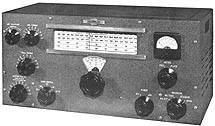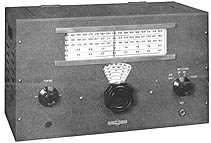310 Exciters
THE COLLINS 310B/C SERIES EXCITERS
The Collins PTO (permeability tuned oscillator) exciters give you not only the flexibility and convenience of variable frequency, but also the accurate calibration and high stability inherent in the Collins 70E-8A PTO.
These units provide a precision frequency control usually found only in laboratory instruments. Yet they are built for continous operation under all normal fluctuations in operating conditions.
The slide rule dial roughly indicates operating frequency, while the vernier dial provides a direct reading in kilocycles. There are no reference charts or curves to interpolate. Accuracy and stability are so high as to be surprising to one who has not previously operated Collins PTO equipment. Actual coverage of the PTO is from 1600 kc to 2000 kc. Sixteen complete turns of the vernier dial are required to cover this 400 kc range.
APPLICATION
The 310B was first designed as a veratile, band-switching, self-powered exciter unit. However, the pilot model’s excellent behavior, with an input of 40 watts on all amateur bands under 32 megacycles, leb to the question as to how it would perform as a low-power CW transmitter. The result of repeated tests was so gratifying that it was decided to offer the 310B in two forms. The first, the 310B-1, has a link circuit output to work into a final of higher power. The second, the 310B-3, has a series-parallel tunable matching antenna network, of the type known as universal, which will match any antenna having an integral number of 1/4 waves in length. Except for their output circuits, the 310B-1 and the 310B-3 are indentical.
The extraordinarily accurate and stable 310B-3 low power transmitter will find many uses around any shack. It makes a highly satisfying standby transmitter, is a natural for spot frequency network, and is the answer for emergency work due to its low power source requirements. Also, it is unexcelled for the beginner in ham radio. At a later date, when more power is called for, he has only to add the final amplifier stage.
R-F CIRCUITS
The 6SJ7 PTO is followed by three 6AG7 multipliers and a 2E26 r-f amplifier. The multipliers are gang tuned and imploy bandswitching. Plug-in coils are utilized in the 2E26 plate circuit. Output coupling is by means of a link on the plate tank coil.
Keying is accomplished by applying blocking bias to the grid circuit of multiplier stages. A keying filter is included, to remove any clicks. Protective bias is provided for keying purposes. Voltage regualtion is applied to the oscillator in order to maintain the excellent characteristics at higher frequencies. The keyer circuit also includes a side tone oscillator which is used as a CW keying monitor. The key jack is on the rear of the chassis.
Condenser tuning is utilized in the multiplier stages. Trimming is accomplished by varying the position of a powdered iron core in each coil, and by adjusting ceramic padder condensers. All trimmers are adjusted from the top of the chassis.
With additional multiplication the 310B-1 makes a reliable frequency control for amateur bands in the VHF and UHF regions.
TUNING AND METERING
The 310B has separate multiplier and amplifier tuning controls, a power ON-OFF switch, a function switch with M.O. OFF – M.O. TEST – STANDBY – SEND positions, a bandswitch, and a meter switch for reading PLATE and GRID currents in the 2E26 stage.
In the M.O. TEST position plate voltage is applied to the oscillator and buffer stages. Thus, with the meter switch in the GRID position, the frequency can be set and the multipliers tuned. In the STANDBY position filament voltage is on, but the plate voltage is removed from the final and buffer stages. The SEND position applies plate voltage to all tubes. By turning the meter switch to PLATE the meter will read the 2E26 plate current and that stage can be tuned.
CALIBRATION CHECKS
See the paragraph “Calibration” in the description of the 310C-2.
RECEIVER CONNECTIONS
The receiver disabling circuit operates on the SEND position. The receiver muting circuit allows fast, quiet CW break-in operation with the 75A-1 receiver, provided separate antennas are used.
TRANSMITTER CONNECTIONS
Power circuits in both the transmitter and the exciter can be interconnected so that the exciter power ON-OFF switch will control the entire equipment. In the SEND position, the exciter function switch connects the ground circuits of the exciter power supplies. Therefore, if the SEND position contacts are connected to the transmitter send-receive switch or relay, the exciter function switch can be left in the STANDBY position. This method has the advantage that the exciter function switch can be set to the SEND position for tuning purposes, yet only a single control is needed for sending and receiving.
TUBE COMPLEMENT
1-6SJ7 PTO
3-6AG7 Multipliers
1-2E26 R-F amplifiers
1-5R4GY H.V. rectifier
1-5Z4 L.V. rectifier
1-6H6 Bias rectifier
1-VR105 Voltage regulator
1-VR150 Voltage regulator
DIMENSIONS: 19″ w, 10 3/8″ d, 9 3/16″ h.
POWER SOURCE: 115 volts a-c + or – 10%.
WEIGHT: 310B-1 – 37 lbs.; 310B-3 – 42 lbs.
NET DOMESTIC PRICE*, complete with tubes and instruction book:
310B-1 Exciter . . . . . . . . . . . . . . . . $190.00
310B-3 With antenna network . . . . . $215.00
Exclusive of any state or local taxes. *3-49 brochure
THE 310C-1
ADDS VERSATILITY TO YOUR RIG
The 310C-1 exciter is a straightforward unit consisting of a 70E-8A PTO and a multiplier, with an r-f output of approximately 80 volts rms acoss 40,000 ohms. Its output frequency is from 3.2 mc to 4.0 mc. The output of the 310C01 can be plugged into the crystal socket, or applied to the grid of an 807 buffer stage, thus giving your present rig a versatility far greater than a large number of crystals could afford. At the same time you keep crystal accuracy and stability.
CIRCUIT
A Collins 70E-8A PTO is followed by a 6AG7 multiplier. A key jack is inserted in the 6AG7 cathode circuit. Two voltage regulator tubes, a VR105 and a VR150, are supplied to insure good keying characteristics. The r-f output is capacitively coupled to a coaxial lead and can be fed directly to the grids of a tube.
CONTROLS
In addition to the PTO dial there are two controls, one of which is the 6AG7 PLATE TUNING. The other is a function switch with the following positions: M.O. OFF, M.O. ON, STANDBY, SEND.
CALIBRATION CHECKS
See the paragraph “Calibration” in the description of the 310C-2.
DIMENSIONS: 15 3/16″ w, 8 3/8″ d. 8 3/4″ h.
WEIGHT: 14 pounds net.
NET DOMESTIC PRICE, complete with tubes and instruction book:
310C-1 Exciter, without power supply . . . . . . . . .$85.00
Exclusive of any state or local taxes.
THE 310C-2
PROVIDES BASIC REQUIREMENTS
The 310C-2 is similar to the 310C-1. The only difference is that it has a self-contained power supply. In this unit you get a highly accurate and stable variable frequency control that is useful in many applications. Add professional performance to your rig by plugging the output of the 310C-2 into the crystal socket.
You’ll find it a versatile instrument for test purposes, too. The accuracy and dependability suggest using it for aliging receiver amateur bands, and in heterodyne frequency meters.
CALIBRATION
An adjustable index on the vernier tuning dial can be set from the front panel for extreme accuracy. Utilizing the 6.4 mc – 8.0 mc scale, one division on the vernier dial represents one kilocycle. To check the accuracy of the oscillator, use the following table which gives the dial setting, oscillator harmonic, and the WWV time signal against which the oscillator is to be checked.
WWV (mc) Osc. Har. Dial Setting
15 8 7.500
15 9 6.666
10 5 8.000
10 6 6.666
5 3 6.666
TUBES
1-6SJ7 PTO
1-6AG7 Multiplier
1-6X5 Rectifier
1-VR105 Regulator
1-VR150 Regulator
POWER SOURCE: 115 volts a-c + or – 10%.
DIMENSIONS: 15 3/16″ w, 8 3/8″ d, 8 3/4″ h.
WEIGHT: 18 pounds net.
NET DOMESTIC PRICE*, complete with tubes and instruction book:
310C-2 Exciter . . . . . . . . . . . . . . . . $100.00
Exclusive of any state or local taxes. *3-49 brochure

